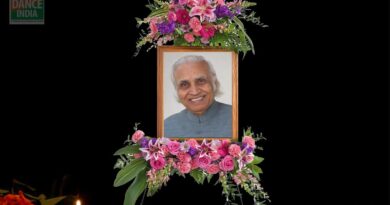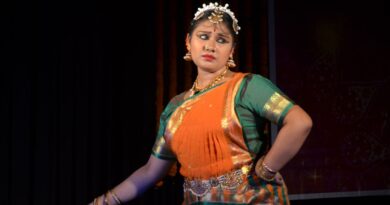Article: KATHAKALI

Dr. Kanak Rele
Padmabhushan, Akademi Ratna (Fellow of Sangeet Natak Akademi)
Director, Nalanda Dance Research Centre
Kathakali is the story narrative dance art form from the southern state, Kerala. Kathakali formulates from, “Katha” meaning a story and “Kali” meaning a dance or a performance. It is a composite art, where different actor-dancers take different roles. The stories are usually from the Indian epics, Ramayana and Mahabharata.
Kathakali is a very majestic art and the costumes portray that a good deal aesthetic values have gone into formulating of this art. The concept is of ‘total theatre’, where acting, music – both vocal and instrumental, the color psychology and the costumes play their peculiar roles.
A typical kathakali performance starts by lighting of the ceremonial lamp. It has just two wicks – one wick is towards the audience and the other towards the stage. It signifies that the light of knowledge must be spread; not only to the actors, but also to the audience. The message conveyed is, ‘the victory of good over evil’. Kathakali can be described as the “theatre of imagination”, where demons and angels clash in the realm of imagination, where the angels are eventually victorious.

‘Kathakali’ incorporates the most intricate make-up code, costume, face masks, head dress and brightly painted faces among all Indian classical dance forms. Its unique costume, accessories and make-up complimented with spectacular performance, music and lightings bringing life to the characters of the great epics and legends attracts and flabbergasts both young and the old thus creating a surreal world around. The make-up of the Kathakali dance form is complicated and the vividly colorful make-up among the Indian classical dance styles. The make-up is called aharya-abhinaya and it follows the color-psychology of the cultural tradition.

The characters are divided into certain categorized groups. The uttama characters are the lofty characters, the madhyama characters are the middling characters and the adhama character are the lowly characters, designated with their individual customized color palette.
For instance, if a green color base is applied on the face, which is called the pachha make-up; signifies the good or high sort of characters. The middling characters have a ‘knife-likei’ pattern called ‘katti’ pained on their cheek. The lowly sort of characters, the through going rascals are called the beard or tadi veshams and they wear red and black predominating. Their cheek is outlined by a white outline, called chutti, made up of strips of cloth which are bound together by a paste made up of rice flour and lime.
A traditional Kathakali performance starts with playing of the auspicious orchestra music, late in the evening. It also signifies as announcement to the villagers around that a performance is going to commence.
The orchestra is traditional and it has not been changed for almost three centuries. The lead singer has a metal disc in his hands which is called ‘chengala’. There is the secondary singer who has heavy cymbals in his hands which are called ‘yelatalam’. The cylindrical drum, the ‘chenda’, is played by two sticks. The ‘maddalam’, which is very ancient percussion instrument, is played by adding some coating on the fingers of the right hand in order to give resonance. The mode of singing is ‘Sopana Sangitam’, indigenous to Kerala.
In the Kathakali dance form, the footwork is very interesting and unique. The foot is placed on the ground with it’s the outer edge of the sole. This gives the necessary spring-action in the walk. The legs provide the solid base for the billowing skirts, and the waist acts as the pivot for the torso to perform the full movements.
Another noticeable tradition of Kathakali, is the “curtain raise look”‘ Before every character makes an entry; the curtain is veiled and to the sounding of the drums, it is slowly unveiled to reveal the character. The curtain is quivered, so that the audience would be aware the type of character which is about to enter, either a gentle or a demonic character and then the character comes into light from drapes unveiled

The color psychology of the VESHAM’S are explained
- Pachha (Green base) – The sathvika characters of gods like Lord Rama, Lord Krishna, great heroes like Arjuna, Nala etc.
- Katti (Green base) – The rajasika characters e.g. Ravana, Duryodhana etc. These are basically courageous people, but they have an evil streak in their character resulting in the katti like a ‘knife drawn’ on the cheeks to denote the evil streak that deforms the basic pattern on the cheeks
- Tadi -The tamasika or lowly characters.
- Red beard – Evil character like Bakasura etc.
- White Beard – Low born characters who are saintly like Lord Hanumana
- Black beard – Jungle folk and very low being like hunters
4. Minukku – Shining make-up for women characters, sages, Bramhins
5. Kari – Black make-up for low females like demonesses, huntresses etc.

Historically, the Kathakali dance form is the outcome of a long line of the theatrical practices. The gems of Kathakali are to be found in the ‘Kutiyattam’, the Sanskrit drama which has been the preserve of the Chakkyar Brahrnin community for almost 2000 years. There are references to be found in the Southern epic, ‘Shilappadikaram’ which describes a dance that a Chakkyar presented in the honour of the victorious king. The present form of Kutiyattam was finalized in 1000 A.D.
Together with the Chakkyar’s art flourished ‘Nangyar Kuttu’ performed by women. In the 16th century, we come to the next phase in the development in the Krishnattam which presents the Krishna cycle in eight days. Later in the 17th century developed the Ramanattam which presents the Rama cycle. It is Ramanattam, which is no more practiced, which resulted in Kathakali.
Kathakali provides a window into the past and an opportunity to understand the ancient heritage that has been preserved for centuries in the Kathakali plays.




